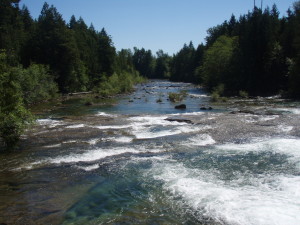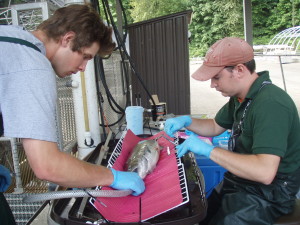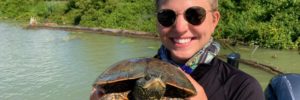Each summer, Chinook salmon on the east coast of Vancouver Island swim upstream into the Puntledge River to spawn. Salmon have to overcome natural barriers such as waterfalls on their journey, but increasingly hydropower developments are
causing migration challenges. For example, in many rivers that divert water for power generation, consistent low flows make it difficult for the fish to pass these obstacles.
Dr. Caleb Hasler studied the migration biology of Chinook salmon in the Puntledge River as part of his Ph.D. thesis at Carleton University. The results from his research were recently published in the journal Aquatic Sciences. The project involved BC Hydro, Department of Fisheries and Oceans, and the University of British Columbia. It “was a great opportunity
to collaborate with a range of agencies including government, industry, and the private sector,” says Caleb.
Salmon use cues to know when to migrate upstream. One such cue includes natural rainfall events that cause large volumes of water flow downstream. If water levels are too low or too high,
fish may delay migration, waste energy, or not migrate at all.
The goal of Caleb’s project was to determine if experimental “pulse flows” could assist in the migration of Chinook salmon. These pulse flows would mimic a natural runoff event. From 2007 – 2009, Caleb inserted 100 Chinook salmon with radio-tags and tracked their activity from June until August. The fish were exposed to 13 pulse flows over the 3 years. By tracking them, Caleb was able to calculate and compare their migration rate and energetic activity during these events.
In general, there was a mixed response to pulse flows. Several pulse flows corresponded with significant upstream movement by the Chinook salmon, which is encouraging for future management scenarios. Additionally, potential negative side effects such as significant increased energy-use were not observed. While “this study focused on pulse flows, other studies we completed on the river showed that temperature, habitat, and physiological condition played a role in migration success,” says Caleb.
The take home message from Dr. Hasler is that fish are “responding to many stimuli as they migrate in hydropower-impacted rivers. Managers need to consider more than just flow when determining the best strategies to promote healthy rivers.” Findings from this study will support BC Hydro’s Water-use Planning and assist fisheries managers in managing imperiled stocks of Chinook salmon.


Dr. Caleb Hasler is currently a biologist and research scientist with Dillon Consulting Limited in Ottawa.




